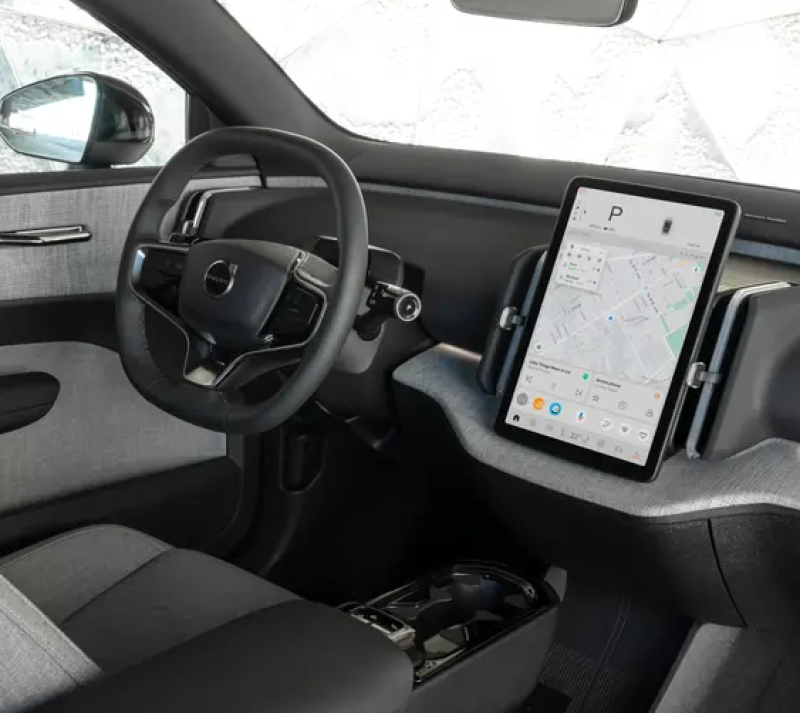2025 Volvo EX30 First Drive: An EV Value That's Worth the Wait


I take an early drive in Volvo's upcoming EX30, the automaker's smallest, quickest SUV yet, and one of next year's most anticipated new electric vehicles.

This would be my choice, if I want to stretch my budget a bit.
Excellent performance, quality interior.
Volvos are kinda expensive, and there's a reason: they're good cars!


Oh, I've been looking forward to this one!
From the moment it debuted earlier this year, Volvo's new EX30 has been my most anticipated electric vehicle of 2024. The compact SUV promised ample range, Scandinavian style and exciting performance for a price and value that turned heads quicker than its claimed 3.4-second 60-second sprint. Having driven the new EX30 for myself, I can say that Volvo's smallest SUV, while not perfect, is quite good and should be well worth the wait.
The new EV value king?
Cars have risen in price over the last few years. While researching our guide to the least expensive electric cars and SUVs, I learned that the average new vehicle transaction price in the US has climbed to around $48,000 which is 24% more than the September 2020 average. And electric cars are even more expensive, averaging around $50,683 -- a number that is sure to climb as the current least expensive and best selling EVs, Chevrolet's Bolt EV and EUV, cease production later this year. So when Swedish automaker Volvo saunters in with a $36,245 starting price (including the $1,295 destination charge), build quality and range that look this good, I take notice. And so should you.
One motor, more range

The EX30's exterior feature familiar Volvo design elements, such as the segmented Thor's Hammer light signature.
On Spanish highways around Barcelona, I found that I was more than happy with the level of performance offered by the Single Motor. The steering is a bit light and overboosted for my taste, but the EX30 still feels agile and accurate around bends and mountainous switchbacks. Like most EVs, it is plenty peppy at moderate around-town speeds and, on the highway, it was a silent and fairly confident cruiser. I averaged 3.15 miles per kWh during my short time behind the wheel, but I don't believe the distance traveled was quite enough for an accurate efficiency estimate. I hope to do more extensive range and efficiency testing on my familiar long testing loop once the EX30 arrives stateside next year.
Twin motor performance adds power
The upgrade to the "twin motor performance" spec adds a second motor to the front axle, adding all-wheel drive surefootedness and bringing the total power output to 315 kW (or 422 horsepower). With 400 pound-feet of torque at the ready (and its battery pack at at least an 80% state of charge), the Twin Motor EX30 will sprint to 60 mph in just 3.4 seconds -- earning it the accolade of "quickest production Volvo yet."
Driven with a light foot, the twin motor spec doesn't feel significantly different from its single-motor sibling thanks to the powertrain automatically decoupling the front axle under light loads and cruising to maximize range and efficiency, landing my tested average at 3.70 mi/kWh or within a margin of error of the previous example. However, the additional weight of the dual-motor system and the optional 20-inch wheels on our example come with a range penalty, dropping to 265 estimated miles per charge.

The EX30's dimensions slot in between the Chevy Bolt EV and EUV,
two of our favorite affordable compact EVs.
Just a lil' guy!
The EX30 is a little guy. Technically a subcompact SUV, its dimensions are, I think, more akin to that of a tallish hatchback. From bumper-to-bumper, it stretches 166.7 inches with a 104.3-inch wheelbase between. For context, those figures place the EX30 scale right in the middle of the Chevy Bolt EV and EUV though, at 61.2 inches tall and 72.3 inches wide (excluding mirrors), the Volvo's stance is lower and wider than either.
The subcompact Swede comes close to matching the Chevrolets' cargo space, but no cigar. With 14.1 cubic feet behind the second row and 31.9 cubic feet with the seats folded flat, the Volvo is significantly less roomy than the Bolt's 57 cubes -- though, much of the Bolt's advantage comes from vertical space, which doesn't really make a huge difference in day-to-day hauling. The Volvo offers the advantage of 0.2 cubic feet of underhood storage -- just enough space for a roadside emergency kit or your portable charging cable.
Volvo EX30 compared
| 2025 Volvo EX30 | 2023 Chevrolet Bolt EV | 2023 Chevrolet Bolt EUV | 2023 Hyundai Kona Electric | |
| Length | 166.7 in. | 163.2 in. | 169.5 in. | 165.6 in. |
| Wheelbase | 104.3 in. | 102.4 in. | 105.3 in. | 102.4 in. |
| Width | 72.3 in. | 69.5 in. | 69.7 in. | 70.9 in. |
| Height | 61.2 in. | 63.4 in. | 63.6 in. | 61.2 in. |
| Cargo | 14.1 cu. ft./31.9 cu. ft. | 16.6 cu. ft./57.0 cu. ft. | 16.3 cu. ft./56.9 cu. ft. | 19.2 cu. ft./45.8 cu. ft. |
| Curb Weight | 3,858 lbs. / 4,140 lbs. | 3,589 lbs. | 3,680 lbs. | 3,715 lbs. |
| Range | 275 miles (est.) | 259 miles | 247 miles | 258 miles |
Centralized interior design
Outside, the EX30 is simply and handsomely sculpted, sharing elements of its familiar Scandinavian design -- from the Thor's Hammer light signature to its vertical taillights -- with the likes of the larger and XC90 and EX90. However, the cabin steps in a very new direction for Volvo. Here, you'll find extensive use of post-consumer materials like the dashboard composed of recycled window frames, sustainably harvested textiles such a Merino wool and an overall reduction of components and electronics via a technique that Volvo calls "centralization."

Moving all of the controls to the center console (and combining front and rear switches) is a bold move that's sure to frustrate some.
Once it's pointed out, all of the little decisions Volvo made to reduce cost in the EX30's cabin become obvious, but I should stress that the electric SUV doesn't feel cheap. The dash and door panels feel solid and substantial despite their post-consumer origins and I didn't notice a single rattle or buzz coming from anywhere in the cabin over many miles of driving.
Single screen tech
The most obvious example of the centralization concept is the large central display. The EX30 lacks a traditional instrument cluster; all driving data and most of the vehicle controls live on this 12.3-inch, vertically oriented touchscreen. The infotainment is powered by Google Built-In software, which uses Google Maps as the primary navigation software, Google's Play Store and Services for streaming app downloads and Google Assistant for voice control.

The minimalist cabin features a single central 12.3-inch
screen with Google Built-In.
Overall, I found the single-screen system to be well organized and easy to use, with a fairly gentle learning curve. Volvo's software engineers have done a good job of requiring the bare minimum taps to access frequently accessed functions, while hiding rarely used options into smartly organized menus. But drivers who really love their physical buttons and switches may find themselves annoyed by the screen-centric design.
The EX30 will also ship with the latest generation of Volvo's driver aid technologies, split between the Core, Plus and Ultra trim levels. My example featured a driver attention-monitoring system that kept nagging me to keep my eyes on the road if I spent too much time looking at the screen, which was a problem because the screen is where the speedometer lives now. Volvo's representatives assure me that the US spec will be less naggy.
Price and 2024 availability
The 2025 Volvo EX30 arrives stateside next year starting at $36,245 for the Single Motor which will be available in Core, Plus ($40,195) and Ultra ($41,895) trim levels with ascending levels of cabin and safety technology. Meanwhile, the Twin Motor Performance will only be available in Plus ($46,195) or Ultra ($47,895) trims. With the optional 20-inch Aero wheels ($800) and Climate Package with heated seats/steering wheel ($500), we're looking at a $49,195 fully loaded as-tested price.

The Volvo EX30 isn't perfect, but it will be a compelling and attractive value when it arrives next year.
My anticipation levels were high leading into this first drive, but the 2025 Volvo EX30 makes a very strong first impression and lives up to my expectations. We'll need more independent testing to be sure, but I'm confident it'll slot nicely onto our lists of best EVs and most affordable electric cars when it arrives next year.
Editors' note: Travel costs related to this story were covered by the manufacturer, which is common in the auto industry. The judgments and opinions of CNET's staff are our own and we do not accept paid editorial content.

Antuan Goodwin, Reviews Editor, gained his automotive knowledge the old fashioned way, by turning wrenches in a driveway and picking up speeding tickets. From drivetrain tech and electrification to car audio installs and cabin tech, if it's on wheels, Antuan is knowledgeable.


I'd prefer the single-motor, with a bit more range. I mean... that's still 0 to 60 in seven seconds. Quick enough...
Not everybody is independently wealthy and can afford a brand new Volvo. I will stick to my 2015 Chevy Silverado 1500 pickup.
This is expensive... but it gives value for the price. I don't know of any good, low-cost EVs on the American market. Yet...
There are not any and I am not holding my breath that there will be. The infrastructure to support them just does not exist outside of major metropolitan/urban areas and the cities do not really want to invest in that. In addition the range of the vehicles is pitifully inadequate. I live two+ hours away from the nearest charging station and I would run out of power before I got there.
It'll be a few years yet, before rural America is built out. My guess is that gas stations came more slowly to small towns, too, a century ago.
It's still early days, and tech is moving fast. When less expensive foreign cars put pressure on American manufacturers, rural America with get the vehicles and infrastructure it needs.
By the time what you describe happens I will be in the next world and won't have to worry about it.